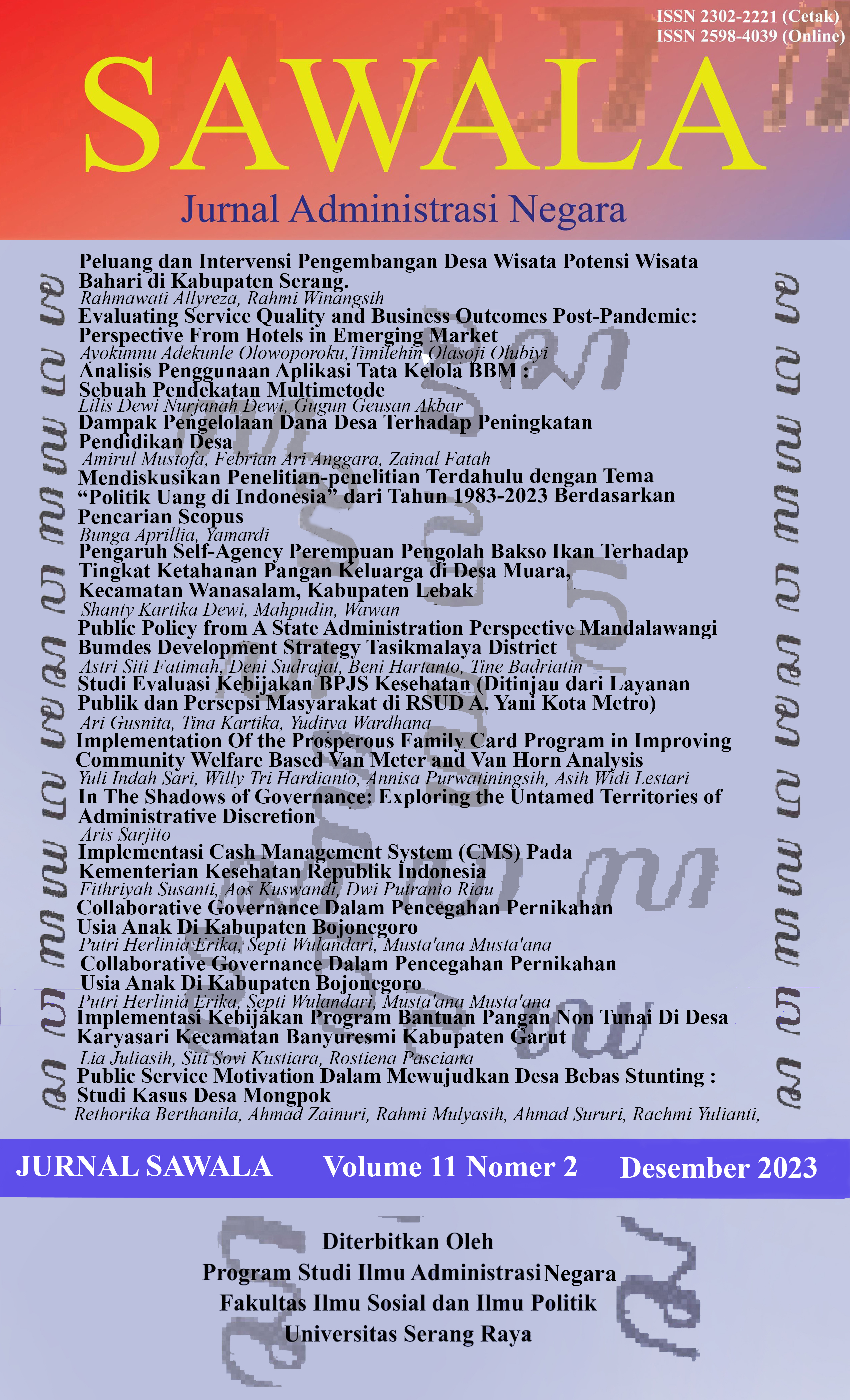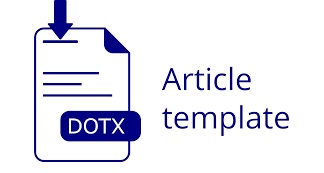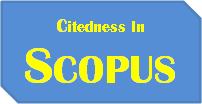Public Service Motivation Dalam Mewujudkan Desa Bebas Stunting : Studi Kasus Desa Mongpok
DOI:
https://doi.org/10.30656/sawala.v11i2.7904Keywords:
Public Service Motivation, Handling Stunting, Village Government, Mongpok Village.Abstract
Stunting is a health and development issue that necessitates collaboration across sectors and active engagement of the community. Using a qualitative case study approach, this study seeks to investigate the impetus behind public service efforts to accelerate stunting reduction in Mongpok Village, Cikeusal District, Serang Regency. The information was gathered via in-depth interviews. Participating in public services about stunting in Mompok village, including midwives, nutrition workers, family planning instructors, PKK cadres, and the village administration, comprised the research informants. Utilizing PSM (Public Service Motivation) theory, the data were examined. In light of the research findings, the village government demonstrates commendable motivation towards public service through its attentiveness and concern for the issue of stunting, collaboration and accountability among diverse stakeholders, ingenuity, and capability to enhance services
References
Ahmad, S., Malik, A., Zainuri, A., Mulyasih, R., & Berthanila, R. (2023). Efektivitas Implementasi Kebijakan Percepatan Penurunan Stunting di Kampung Keluarga Berkualitas Desa Mongpok Kabupaten Serang. 5, 45–53.
Aldawood, F., Kazzaz, Y., AlShehri, A., Alali, H., & Al-Surimi, K. (2020). Enhancing teamwork communication and patient safety responsiveness in a paediatric intensive care unit using the daily safety huddle tool. BMJ Open Quality, 9(1), 1–5. https://doi.org/10.1136/bmjoq-2019-000753
Allen, L. H. (2012). Global dietary patterns and diets in childhood: Implications for health outcomes. Annals of Nutrition and Metabolism, 61, 29–37. https://doi.org/10.1159/000346185
Anditri Weningtyas. (2024). The effect of short course interventions to improve. 18(3), 530–539. https://doi.org/10.20473/ijph.vl18i3.2023.530-539
Anjani, S., Anggraini, F. D. P., Setyawati, V. A. V., Aprianti, A., & Indriati, A. N. (2022). Efektivitas Metode Edukasi Berbasis Mobile Edu App Sebagai Upaya Intervensi Penurunan Stunting Dengan Pendekatan Asuh, Asih, Asah. Jurnal Eduscience, 9(1), 143–151. https://doi.org/10.36987/jes.v9i1.2559
Berthanila, R., Myra, R., Irawati, R. I., & Saefullah, A. D. (2023). Educational Transformation In The Digital Era : The Impact Of Learning From Home Programs , Employee Innovation And Public Service Motivation On Employee Performance. The Saybold Report, 18, 660–676. https://doi.org/10.5281/zenodo.8379170
Bhutta, Z. A., Akseer, N., Keats, E. C., Vaivada, T., Baker, S., Horton, S. E., Katz, J., Menon, P., Piwoz, E., Shekar, M., Victora, C., & Black, R. (2020). How countries can reduce child stunting at scale: Lessons from exemplar countries. American Journal of Clinical Nutrition, 112, 894S-904S. https://doi.org/10.1093/ajcn/nqaa153
Cermeño, A. L., Palma, N., & Pistola, R. (2023). Stunting and wasting in a growing economy: biological living standards in Portugal during the twentieth century. Economics and Human Biology, 51(November 2022). https://doi.org/10.1016/j.ehb.2023.101267
Kemenkes RI. (2019). Laporan Pelaksanaan Integrasi Susenas Maret 2019 dan SSGBI Tahun 2019. Badan Pusat Statistik, Jakarta - Indonesia, 1–69. https://stunting.go.id/?smd_process_download=1&download_id=5219
Miao, Q., Eva, N., Newman, A., & Schwarz, G. (2019). Public service motivation and performance: The role of organizational identification. Public Money and Management, 39(2), 77–85. https://doi.org/10.1080/09540962.2018.1556004
Perry, J. L., & Wise, L. R. (1990). The Motivational Bases of Public Service. Public Administration Review. https://doi.org/10.2307/976618
Piatak, J. S., & Holt, S. B. (2020). Disentangling altruism and public service motivation: who exhibits organizational citizenship behaviour? Public Management Review, 22(7), 949–973. https://doi.org/10.1080/14719037.2020.1740302
Qi, F., & Wang, W. (2018). Employee involvement, public service motivation, and perceived organizational performance: testing a new model. International Review of Administrative Sciences, 84(4), 746–764. https://doi.org/10.1177/0020852316662531
Rahmawati, A., Baroya, N. mal, Permatasari, E., Nurika, G., & Yusi Ratnawati, L. (2022). Potret Persepsi Nilai Gender Dalam Program Percepatan Penurunan Stunting Di Desa Sukojember, Kecamatan Jelbuk, Kabupaten Jember. Media Gizi Indonesia, 17(1SP), 31–38. https://doi.org/10.20473/mgi.v17i1sp.31-38
Richard M. Steers, & Osland, J. S. (2020). Management Across Cultures Challenges, Strategies, and Skills.
Robbins, S. P., Judge, T. A., & Breward, K. E. (2018). [BOOK] Essentials of organizational behavior.
Salam, F., Prawiradilaga, R. S., & Putri, M. (2021). Faktor-Faktor yang Berhubungan dengan Stunted di Kecamatan Ciomas dan Pabuaran Kabupaten Serang. Jurnal Integrasi Kesehatan & Sains, 3(1), 28–32. https://doi.org/10.29313/jiks.v3i1.7315
Saldana, H. and. (2014). Qualitative Data Analysis A Methods Sourcebook (I. SAGE Publications (ed.); First and).
Schott, C., Steen, T., & Van Kleef, D. D. (2019). Reality Shock and Public Service Motivation: A Longitudinal, Qualitative Study Among Dutch Veterinary Inspectors. International Journal of Public Administration, 42(6), 468–481. https://doi.org/10.1080/01900692.2018.1485044
Susanti, N., Priharwanti, A., & Vianti, R. A. (2022). Strategi Akselerasi Penurunan Stunting Wilayah Pesisir Kabupaten Pekalongan. Pena Jurnal Ilmu Pengetahuan Dan Teknologi, 36(1), 49. https://doi.org/10.31941/jurnalpena.v36i1.1917
Vandenabeele, W., Ritz, A., & Neumann, O. (2017). Public service motivation: State of the art and conceptual cleanup. In The Palgrave Handbook of Public Administration and Management in Europe (pp. 261–278). Palgrave Macmillan. https://doi.org/10.1057/978-1-137-55269-3_13
Zubair, S. S., Khan, M. A., & Mukaram, A. T. (2021). Public service motivation and organizational performance: Catalyzing effects of altruism, perceived social impact and political support. PLoS ONE, 16(12 December). https://doi.org/10.1371/journal.pone.0260559









